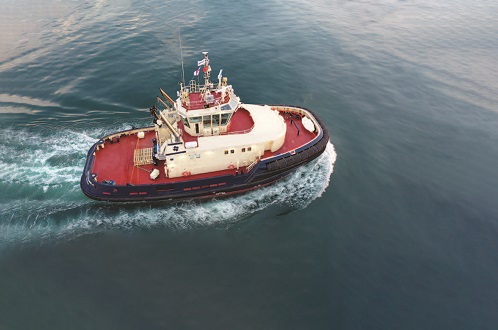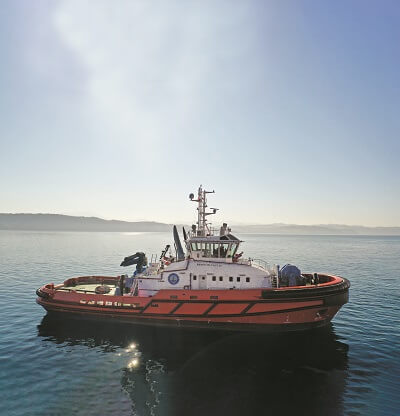Robban Assafina Tours in Eregli Shipyard: A Fully Integrated Shipyard at the heart of the Black Sea
With a determined focus to be the premium provider of tugboats on a global level, #Eregli Shipyard set sail on this journey in 2004, completing numerous projects mainly in tugboats, mooring boats, pilot boats, chemical tankers and several types of vessels.
To this date, the shipyard has built several types of tugboats, designed by Robert Allan and several other naval architecture companies, in addition to its own in-house designs, through its design office in #Istanbul.
Around 1,000 employees over a total area of 162,000 sqm, Eregli Shipyard enjoys being one of the biggest #shipyards in #Turkey, and the biggest in terms of slipway capacity.
Meeting the Manager
Robban Assafina had the perfect opportunity to wander around this huge shipyard, to explore the different facilities and workshops where the building and repair works take place. Kemal Bektas, Eregli Shipyard’s Manager, told us all about the shipyard’s details and capacities: “Nowadays we have 26 vessels under progress in the Eregli Shipyard (2 Pilot Boats, 2 Mooring Boats, and remaining are Tug Boats).”
He added: “The maximum capacity of the shipyard is 50,000 deadweight ton ship that we can build as per the size of the vessel, whereas the maximum capacity we can build is 33,000 ton per year. With tugboats ranging between 10 m with 3-ton bollard pull, and 42 m with 120-ton bollard pull being the primary focus, we can build more than 50 tugboats at once, since we have abundant areas that meet our capacity to take in orders at the same time”, Bektas explained, “It depends on the size of the vessels, we have 4 slipways and we can build vessels up to 250 meters, all depending on the client’s needs and the market.”
We were able to explore the different slipways of diverse slopes at the shipyard, as well as the outdoor assembly areas that are served by Gantry cranes of capacity 360t (3x120t), 250t (2x125t), 80t (2x40t) and 7 units of 32t (2x16t).
As for the transport operations on the field, we saw several mobile cranes of capacities ranging from 30t to 400t, a heavy load transporter of 240t and several forklifts.
Our tour at the shipyard took quite some time to cover the various departments, specialized in planning, purchasing, design, production, quality control, safety, piping, paintings, mechanical workshops, and land facilities, run by 60 engineers, 25 foremen, technicians, and a skilled piping & outfitting & welder team.
| Read More: Med Marine gave Robban Assafina a glimpse of the company’s 2023 huge projects |
A new expansion in the making
Giving us a glimpse of the upcoming expansion at the shipyard, Bektas said that they are working on a new covered area, upgrading the production site in order to build more high-quality vessels and increase the lifting capacities. “The new area will be of 100m length, 25m double beam, and a 160 tons’ capacity and expected to be finalized in the upcoming 2 years.”
Going through the different departments and workshops at Eregli Shipyard, we were accompanied by the Quality Management System Superintendent Fatih Marangoz, who guided us through the amazing stages of the shipbuilding and repair processes, from the cutting area to the montage workshop, painting, assembly till the final check-up and testing.
Cutting area
Robban Assafina team started off with the CNC workshop area, which is run by 10 employees. This workshop includes the initial cutting done according to the design, which is taken afterward to the montage workshop.
We wandered through the Steel Cutting hall spread over 1930 sqm, which has an annual steel processing capacity of 32.000t using 2 units of 7000x28000, 1 unit of 4000x15000 CNC Plasma Cutting Machines, and 2 overhead cranes of 15t.
Montage workshop
In the montage workshop, all needed shapes of the tugs, pilots and mooring boats are pieced together using specific press machines, done by a number of employees, depending on the work overload.
“There are 5 blocks in the montage area and they are related to each other and used to join the pieces together”, said Marangoz, “The winches used to carry and move the blocks are checked every 2 months by our engineers, and yearly by safety professionals.”
Containing one of the biggest winches in Turkey, the shipyard has 360-ton capacity used for transporting and moving the blocks, which are placed upside down to complete the final shape of the tugboat.
The preassembly halls
Escorted by Marangoz, we explored the Shotblasting and the Preassembly halls designed for the blasting and primary coating of steel plates, which is performed by a fully automatic plant. After CNC cutting, sections are prepared for assembly using Hydraulic presses (400t and 300t), a profile bending machine, a guillotine, overhead cranes, welding, and grinding machines.
The next halls we visited during our tour were the Block Assembly halls, where regular blocks (double bottom, side and main deck) are assembled on a panel line of 20x140m (P-6 Hall) in a hall covering 3,180 sqm using various types of welding machines and overhead crane units. As we were going through the paint hall at Eregli Shipyard where the assembled blocks are blasted, Marangoz told us that this hall is climate-controlled year-round, and work is completed in an environment that is designed to achieve successful blasting and coating applications. “The facility consists of two compartments for blasting/painting.”
Outfitting Shops
During the tour, we passed through a number of outfitting shops, covering 5,200 sqm, mainly used for producing several components (ladders, hatches, manhole covers, etc.) as well as pipes. The outfitting quays 230m + 60m + 30m + 30m + 240m lengths and 7m depth is used for final outfitting and tests/trials.
Into the water
After the cutting, painting, outfitting and assembling, the tugboat is then pushed onto a little harbor into the water without starting the engine, and that, according to Marangoz, is done in order to finalize the inner parts of the tug. There are 4 slopes in the shipyard used to drag the vessels into the water, three are used for tugboats and one for chemical tankers.
We were introduced to several machines used to monitor the tugboat, with an underwater radar showing the main engines, in addition to machines equipped with ropes that test the pushing and towing capacity of the tugboats, and specialized machines to connect the main engines to the propellers. After dock trials are completed, 2-3 days’ sea trials are carried out.
All under safety measures
Safety at work is a priority in this shipyard, and check-ups or modifications inside the tugboat are performed after safety professionals give their approvals.
“Workers know that a specific zone is safe for work by seeing a green sign. We also place the orange fences to prevent workers from falling”, commented Marangoz as we walked together alongside the water storage tanks used in case of fires, where a specific bell is available to switch in order to shut down the electricity at the shipyard in case of fires. The forklifts used indoor are also electric and rechargeable, to ensure the safety of the workers on site, avoiding any source of air pollution. Robban Assafina was able to explore the special area specifically designed to contain waste storage discharged from ships that come to the shipyard for repair. “Another part of this area is for fire prevention; we have designed a new pipeline to desalinate seawater in order to use it in fire system prevention. That is why we have 4 water storage areas.”
Recycling
Eregli shipyard, with its 10 workshops including 3 pipe workshops and 2 warehouses, and a specific ship repair section for ships coming from outside the area, painting works section and strength testing, pays a great deal to preserve the environment and limiting pollution, as recycling is an inevitable process that takes place after the whole repair procedure is done. In 2022 the waste disposal plant was established in order to store the waste of ships coming to Eregli shipyard for maintenance and repair. In this way, Eregli Shipyard became able to store the bilge, sludge, and sewage wastes that may come out of the ships. In addition, this waste will be taken out from the shipyard in accordance with environmental legislation to an approved institution.
“The waste produced from the ship repair and building operations are sent for recycling, and if that is not applicable, it is sent to specialized firms to be taken care of. That is why we always seek to purchase convertible and recyclable products”, according to Marangoz.

Onboard the MEDXXIV
Robban Assafina’s rich and unique day tour at #Eregli ended with a little sea trip on board MEDXXIV tugboat, built in 2018, and led by Captain Erdem Akyuz.
While visiting the engine room, Robban Assafina’s team established a full picture of the tugboat’s specifications and capabilities.
“The MEDXXIV tugboat is a Robert Allan Ltd. Design, with basic functions including towing, pushing, mooring and fire-fighting operations,” said Captain Akyuz.
With a length of 23,00m and beam 10,90m, a 50-ton bollard pull and 12 knots’ speed, Robban Assafina was able to experience the comfortable climate-controlled accommodation onboard the MEDXXIV, which included a captain’s cabin, an officer cabin and two double crew cabins.
As for the deck equipment, they include a 240kg (high holding power) anchor and a short link chain 19 mm Gr 2; one fore towing winch; one electric anchor capstan; one electric capstan; a disc type towing hook; 420 cm foldable rescue boat; cylindrical rubber fenders; and 2 life rafts on top deck accommodating 10 persons.
Robban Assafina Magazine, Issue 83, Jan./Feb. 2023, Special Report, pg 93
| Read Here | |
 |
|





































